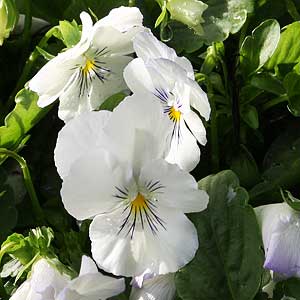
If you are looking for a sure fire, colorful spring plant, then pansies may be the plant for you.
Wonderful plants when grown in a pot, the color range is incredible, the flowers large after a cold winter they are welcome.
Pansies are the number one bedding plant for winter in many states.
Pansies that we see today are hybrids, bred from Violas and hybridized in England for over 100 years. Nearly all have Viola tricolor in the parentage and this explains the color variations , the botanical name is Viola x wittrockiana.
Although they are grown as annuals, they are actually a short lived perennial. They can easily be grown in climate zones, as long as you choose the right time of year to plant them.
Colors from pale yellow to a very deep purple, with orange and blue in between. You can get multi color, striped, ruffled petals and even ‘extra large’ flowering types.
The enthusiast can buy seed and start then in a cold frame or indoors in winter, we think that buying a tray of young plants is the easy way to go. When buying young plants look for the short compact growing ones rather than those that have started to get a little ‘lanky’.
Care
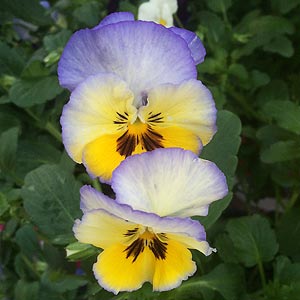
In good conditions pansies are remarkably easy care, one planted and settled in they simply need to be kept moist and away from hot sun.
You can buy flowering sized plants in spring and plant then out directly.
Or you could buy seedlings in early fall, these can be planted out before the frosts and will come back ready to flower in spring.
If you are planting seedlings look for the shorter ones, they seem to be stronger.
- Humus rich moist soil
- Sunny position
- Deadhead for repeat flowering.
- Water thoroughly once a week, and always in the morning, this helps prevent disease by allowing the plants to dry out before nighttime.
Planting ideas include grow them in a hanging baskets, containers, window box or in the garden border.
As long as the soil is rich and moist pansies will not mind.
Plant seedlings early, as soon as the frosts are over. Pansies love the cool weather, but fade away quickly as the hot weather comes around.
If you can keep them going through summer with some shade and a little water, and dead-heading, pansies will bounce back in fall to give you another show of color.
Varieties
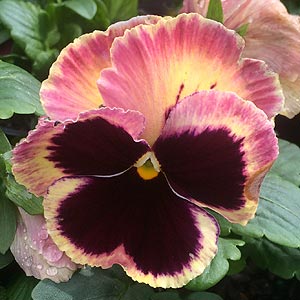
The hybrids are the ones most gardeners are after, and these come in different forms. The bigger the flowers the less they perform, smaller flowering types flower better and are hardier.
- Trailing pansies are simply those with a lax habit, they are best suited to hanging baskets.
- Many named cultivars, all with different flower colours, although some are better for winter flowers than others.
- Bolero come in a range of colors with 3 inch flowers
Sorbet mania
Cool Wave have smaller flowers to around 2 inches, very vigorous and one of the best for hanging baskets.
Frizzle Sizzle have petals that have wavy margins, again a range of colors. - Freefall are another that are excellent for hanging baskets.
- Majestic Giants have 4 inch flowers
- Colossus have the largest flowers, some to 4 inches.
Propagation
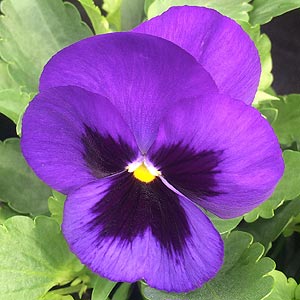
Seeds can be planted in late summer to fall for early spring flowering. In warmer zones you can plant them earlier for winter flowering.
Pansy seeds need darkness to germinate.
- Sow on the surface and lightly press down to gain firm contact between seed and soil.
- Lightly sprinkle some soil over the top.
- Cover with cardboard or newspaper.
- Seeds should geminate in 2 – 3 weeks.
- Do not transplant for another 4 weeks.
- Allow to harden off a little before planting.
- Use a good quality soil mix
- Water in well with a liquid seaweed fertilize.
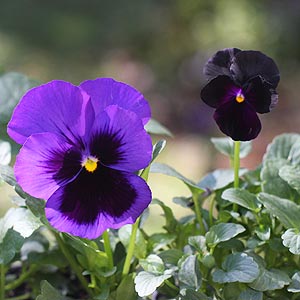
Pansy or Viola ?
Both Pansies and Violas are actually violas, its just that they are hybridised from different species. This gives them different characteristics.
- The bedding Violias we see for sale are hybrids of Viola cornuta.
- Pansies are hybrids between V. tricolor and V. lutea
The difference between what we call Pansies and what we call Viola is simply that the Pansies are large flowers hybrids, known as Viola x wittrockiana and usually have blotching which gives them a face.
We have pictured a typical ‘Pansy’ and ‘Viola’ side by side for comparison.
Viola are smaller flowered and the species name is Viola cornuta, they do come as single colors, bi colors and tricolors, some with speckles, but not the ‘blotch’.
- Sweet Violets are Viola odorata
- ‘Johnny-Jump-Up’ is a annual variety that will self seed.
Top Tips
- Pansies require a temperatures range of around 45-65°F.
- Temperature below 25°F can cause the plants to die back.
- Sudden drops or rises in temperature can cause problems.
- High nitrogen fertilisers are not recommended.
- Deadheading, watering during dry spells and mulching will promote good growth.
- Mulching helps keep the soil at a more even temperature.
- Move pansies to a shaded position over summer if you want them to survive.
Summary
- Add compost to the soil, fertilise once a month, compost, compost tea and bone meal fertiliser.
- In warmer climates over summer pansies will suffer, the flowers will stop and general under perform. You can try to keep them going by keeping them moist and deadheading them through summer.
Looking at Bulbs in more detail
Where to Buy
You can buy pansies and pansy seed from online suppliers and garden centers from fall through to spring.

